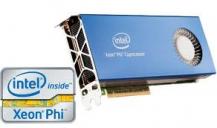
It allows to keep PV going, with more focus towards AI, but keeping be one of the few truly independent places.
-
Intel released a 60ghz pci-express co-processor
Will this processor work for improve real time preview and rendering time in video editing?
If it works for video editing maybe it can accelerate all effects, filters, preview and render in premiere and after effects, not just some effects like nvidia cuda does.
Will it be available for video workstations or just for server and scientific work?
Will it work in i5 / i7 motherboards or just in xeon motherboards?
Will each software need to be redesigned for it or just the windows can do the interface between software and it?
http://ark.intel.com/pt-br/products/71992/Intel-Xeon-Phi-Coprocessor-5110P-8GB-1_053-GHz-60-core

 phi.jpg292 x 172 - 8K
phi.jpg292 x 172 - 8K -
Probably XEON only - http://communities.intel.com/message/173563 Adobe/AVID/Sony would have to rewrite some code but otherwise think it could work. It is basically a whole 60 core (240 thread) 1ghz Ivy Bridge computer on a card, running linux. Pretty Cool!
-
As far as I know it is much simplaer than Ivy Brifge cores.
Plus such thing is really complicated to write things on.
-
How different in reality would this be from running an Nvidia card with CUDA enabled apps?
-
@jpbturbo From my quick read of the Intel fact sheet, it's not any different. The difference is a program can be easily coded to use the XEON Phi when available. While CUDA enabling requires a complete rewrite.
Also, the Phi cards could be stored in a simple (home) server and accessed by a laptop over gigabit.
-
It won't be used for ordinary things, like video encoding, etc. It is very niche product. May be for reytracing, etc.
The difference is a program can be easily coded to use the XEON Phi when available. While CUDA enabling requires a complete rewrite.
This is not right. Such high parallel architectures require certain software design. CUDA tools now are much better and more mature.
-
Very interesting. I wonder if this is like what nVidia's Maximus to the GPU.
-
"60 GHz" really isn't happening at all, here, just ~ 60 cores @1GHz.
Basically, Phi is Intels new label for what was formerly called "Larrabee" - an attempt to finally offer something competitive to the GPUs from nVidia and AMD (formerly ATI). Once Intel realized their many-Pentium4-like-core technology Larrabee would not fly when competing with nVidia and AMD in the graphics cards market, they repositioned their product as a pure computational add-on and renamed it. Certainly, the Phi cores are somewhat more easy to program for "general purpose" things than nVidia or AMD GPUs, but it remains to be seen if that advantage outweighs the Phis inferior raw computing power (in comparison to the competitors GPUs) and their relatively high power consumption.
Maybe Intel can byte off a share of the GPU market by offering good support, tools and competitive pricing, but Phi is all but a sensational new thing.
Howdy, Stranger!
It looks like you're new here. If you want to get involved, click one of these buttons!
Categories
- Topics List23,993
- Blog5,725
- General and News1,354
- Hacks and Patches1,153
- ↳ Top Settings33
- ↳ Beginners256
- ↳ Archives402
- ↳ Hacks News and Development56
- Cameras2,368
- ↳ Panasonic995
- ↳ Canon118
- ↳ Sony156
- ↳ Nikon96
- ↳ Pentax and Samsung70
- ↳ Olympus and Fujifilm102
- ↳ Compacts and Camcorders300
- ↳ Smartphones for video97
- ↳ Pro Video Cameras191
- ↳ BlackMagic and other raw cameras116
- Skill1,960
- ↳ Business and distribution66
- ↳ Preparation, scripts and legal38
- ↳ Art149
- ↳ Import, Convert, Exporting291
- ↳ Editors191
- ↳ Effects and stunts115
- ↳ Color grading197
- ↳ Sound and Music280
- ↳ Lighting96
- ↳ Software and storage tips266
- Gear5,420
- ↳ Filters, Adapters, Matte boxes344
- ↳ Lenses1,582
- ↳ Follow focus and gears93
- ↳ Sound499
- ↳ Lighting gear314
- ↳ Camera movement230
- ↳ Gimbals and copters302
- ↳ Rigs and related stuff273
- ↳ Power solutions83
- ↳ Monitors and viewfinders340
- ↳ Tripods and fluid heads139
- ↳ Storage286
- ↳ Computers and studio gear560
- ↳ VR and 3D248
- Showcase1,859
- Marketplace2,834
- Offtopic1,320






